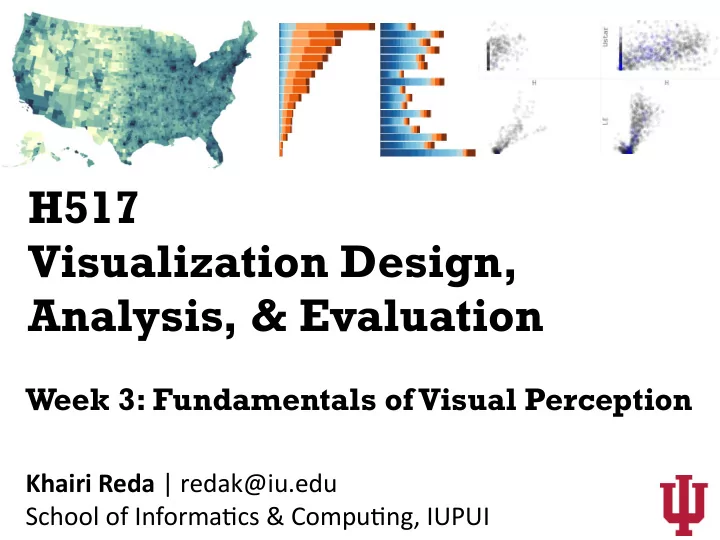

H517 Visualization Design, Analysis, & Evaluation Week 3: Fundamentals of Visual Perception Khairi Reda | redak@iu.edu School of Informa5cs & Compu5ng, IUPUI
Last week…
The D3 stack D3 JavaScript HTML SVG Scalable Hypertext markup language Vector graphics
This week Fundamentals of Visual Percep5on and Cogni5on
Perception vs. Cognition Percep-on Iden5fica5on and interpreta5on of physical sensory input Cogni-on The processing of informa5on and applying knowledge Recording and retrieving informa5on from memory Percep-on: Hearing someone speak Cogni-on: Understanding words, remembering informa5on Based on a slide by Alex Lex
Perception vs. Cognition Perception Cognition •Object recogni5on •Rela5onship between objects •Eye, op5cal nerve, primary visual cortex •Remembering shapes or •Basic visual features (e.g., edges, paQerns orienta5on, shapes) •Learning new shapes •Unconscious •Problem solving •Deliberate •Requires a3en-on Based on a slide by Alex Lex
The boundary between perception and cognition is hard to delineate Perception -> cognition Cognition -> perception
Faces in Things
Take home point What we see is influenced by visual features our brain perceive (boQom-up) and by what we know beforehand (top-down)
The human visual system Illustration from Wikipedia
The human visual system https://www.researchgate.net/figure/Processing-steps-of-the-visual-stream-a-The-cellular-organization-of-the-retina-from_fig1_233971662
The human eye light electricity http://www.fortworthastro.com/images/eye_xsection_01.jpg
rods ~120 million highly-sensi5ve to light not sensi5ve to color good for low-light vision cones ~5-6 million sensi5ve to color require good ligh5ng sharp vision ganglion cells “Structure of the Mammalian Retina”, Ramon y Cajal Based on a slide by Alex Lex
Electron microscopy of photoreceptors Wandell, “Foundations of Vision”
Cones types HyperPhysics, Georgia State University
Cone distribution by pigment color blindness normal vision (red deficiency) Wikipedia
Density of rods/cones E. Goldstein, “Sensation and Perception” Adapted from Lindsay & Norman, 1977 Via Miriah Meyer
C. Ware Visual Thinking for Design
Vision Human vision does not work like a camera The eye makes a series of fixa-ons and saccades fixa-on: maintaining gaze over a single loca5on ( 200-600ms) saccade: movement between loca5ons 20-100ms Based on a slide by Alex Lex
Retinal Ganglion Cells Bear, Connors, Paradiso, “Neuroscience” Via Miriah Meyer
Retinal Ganglion Cells Wikipedia Via Miriah Meyer
activity increased low activity from (or decreased) center and surround at edge Miriah Meyer
Annie Prud’homme-Généreux Via Miriah Meyer
Via Miriah Meyer
Via Miriah Meyer
Cornsweet illusion
Visual perception is relative
Visual perception is relative Differences in color are rela5ve
Visual perception is relative Differences in contrast is rela5ve
Visual perception is relative Color interac5on Wong 2010 Via Miriah Meyer
Visual perception is relative Sizes are rela5ve (Ames room)
Take home point Our visual system see differences, not absolute values. Based on a slide by Miriah Meyer
POPOUT
which side has the outlier?
which side has the outlier? C. Healey, 2007
which side has the outlier? C. Healey, 2007
which side has the outlier? use a single popout channel at a time (e.g., either difference in color or shape alone) to draw attention C. Healey, 2007
Popout channels no popout C. Ware “Information Visualization”
Semantic Depth of Field C. Ware “Information Visualization”
Semantic Depth of Field R. Kosara
Popout / pre-attentive processing • Very fast at grabbing aQen5on (less than 200 milli seconds) • Popout elements have to be salient compared to surrounding • Elements that are a conjunc-on of mul5ple channels oben do not pop out
How does pre-a3en-ve processing / pop outs work? We don’t know for sure, but there are some theories: https://www.csc.ncsu.edu/faculty/healey/PP/ index.html#Preattentive_Theory
Take home point We can easily see objects that are different in color and shape, or that are in mo5on Visual features must be carefully designed. Conjunc5ons must be avoided, if popout is desired Use color and shape sparingly to make the important informa5on pop out Based on slides by Miriah Meyer & Alex Lex
Gestalt grouping principles
Gestalt grouping principles gestalt : form in German “The whole is other than the sum of its parts” Our brain has innate capacity to see paQerns that transcend the visual s5muli the produce them
proximity Andy Rutledge, “Gestalt Principles of Perception”
proximity Alex Lex
proximity B. Wong, “Gestalt Principles, I”
similarity B. Wong, “Gestalt Principles, I”
similarity Andy Rutledge, “Gestalt Principles of Perception”
connectedness Ware, “Information Visualization”
link surface outline enclosure Alex Lex
A li3le experiment… How many groups do you see? color size shape proximity similarity similarity similarity Based on a slide by Alex Lex
A li3le experiment… How many groups do you see? color size shape proximity similarity similarity similarity Based on a slide by Alex Lex
A li3le experiment… How many groups do you see? color size shape proximity similarity similarity similarity Based on a slide by Alex Lex
grouping B. Wong, “Gestalt Principles, I”
grouping
grouping Jorge Camoes Via Miriah Meyer
grouping - common fate
closure
closure
figure / background Mariah Meyer
Gestalt principles similarity: objects that look like each other (in size, color, or shape) are related proximity: objects that are visually close to each other are related connections: objects that are visually connected are related closure: we see incomplete shapes as complete figure / ground: elements are perceived as either figures or background common fate: elements with the same moving direc5on are perceived as a unit Mariah Meyer
next week… color perception
D3: Data-Driven Documents
Exercise 3: Repeat the previous exercise. Instead of using pure JavaScript, use D3 selec5ons selection and data binding selection and data binding
Recommend
More recommend